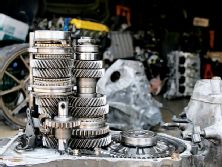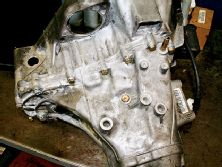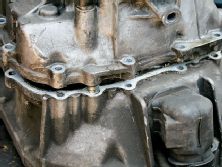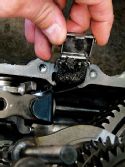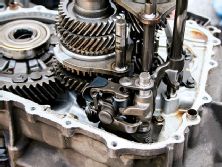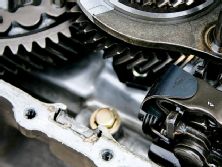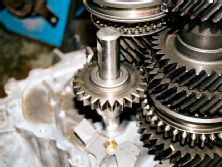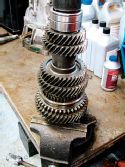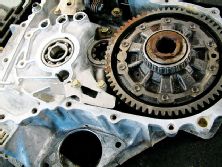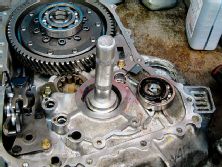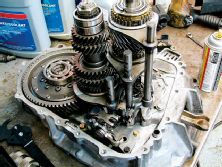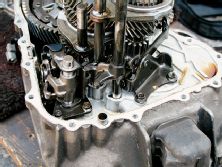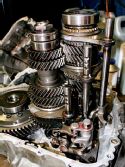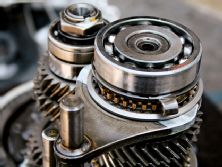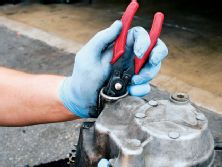Gearing changes everything. It can make a slow car feel quick and a quick car feel slow. Honda engines typically have narrow rpm ranges where both horsepower and torque are at their maximum. The transmission's job is to allow for near seamless changes between the engine and the car's wheels as vehicle speeds change. Shifting allows the engine to stay below its redline but remain close to its sweet spot. Ideally, a transmission would have an infinite number of gears, each of which would keep the engine operating at its most ideal rpm, but unless you're talking about continuously variable transmissions (CVT), which aren't exactly suited for sizeable amounts of torque, then gearing becomes really important.
A typical B-series Honda transmission has two main shafts inside of it that mesh with one another via sets of gears -the mainshaft, also referred to as the input shaft, and the countershaft, or output shaft. Both are fitted with a series of gears, synchros, and bearings, among other important parts. The mainshaft is connected to the engine through the clutch and spins however fast the engine spins-it has no choice. If you have a five-speed transmission, then up to five different gears are applied, which results in five different rpm values at the countershaft, ultimately translating into what the drive wheel(s) see. Gears simply act as torque multipliers and help make the best use of the engine's available torque, whether you're accelerating from a stop or cruising down a hill. For example, a 1.360:1 gear ratio simply means it takes 1.36 mainshaft turns for every output shaft turn. Gears alter a vehicle's wheel speed and the amount of torque that's applied in relation to the engine's speed and torque values, but five or six gears planted along these two shafts aren't the only ways to get this done.
A transmission's final drive ratio is just as important as its individual gear ratios. The final drive ratio is the speed of the transmission's countershaft versus the speed of the car's drive wheel(s). Think of it this way: A Honda transmission is always operating using two gears-you've got whatever gear you're in and you've got the final drive gear, aka the ring and pinion gear. Take a late-model GSR transmission with a 1.360:1 Third gear ratio and a 4.400:1 final drive ratio. You've got to multiply these two numbers together to get your effective Third gear ratio of 5.984-the actual gear ratio. This means it takes 5.984 engine revolutions to get the wheel(s) to turn once. Pair one of MFactory's 4.928:1 final drive gears to the GSR gearbox like we did and you'll end up with a 6.70:1 effective Third gear ratio. The higher the final drive ratio, the faster the engine rotates for each rotation of the drive wheel(s). Numbers like these result in better acceleration throughout the entire powerband, in any gear. In other words, the numerically higher final drive gear actually applies more torque at any given speed. It's not uncommon to realize power shifts upwards of 40 whp just by playing with final drive ratios.
Keep in mind that altering final drive ratios versus gear ratios are two entirely different ways of reaching similar goals, and both affect torque transfer in different ways. Gear ratios affect the number of engine revolutions in-between shifts while final drive ratios affect the actual vehicle speed in-between shifts. To be sure, an increased final drive ratio is an easy way to increase cruising speeds, decrease fuel efficiency, and potentially decrease top speeds-not always a good thing but one of the necessary evils when you're looking for better acceleration. Never mind all of that though; comparatively speaking, a final drive upgrade is a much more cost-effective method of obtaining shorter gear ratios when compared to a brand-new gear set. You'll get similar results for less work and a lot less cash.
Follow along as we install our new MFactory final drive gear in our hydro GSR gearbox. MFactory gears are cut from high-quality, fully carburized, forged nickel-chromoly steel and undergo a proprietary heat-treating process. MFactory offers a number of ratios and fitments depending on which gearbox you've got and what exactly you plan on doing with your car. Check out MFactory's Web site for details and specifics on its full line of Honda-specific transmission upgrades. Now onto the install.

